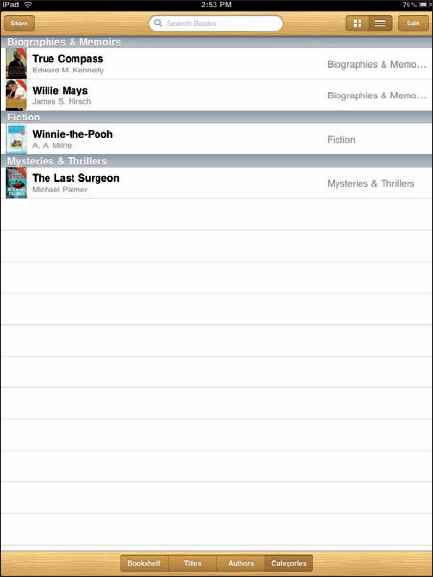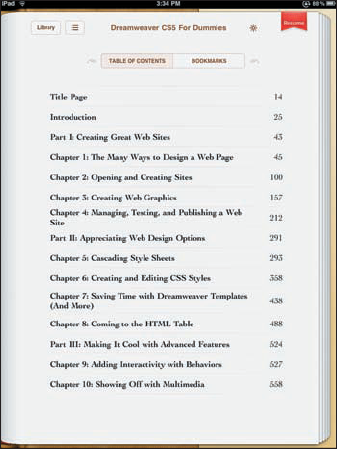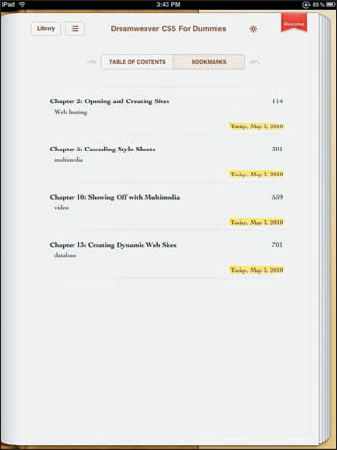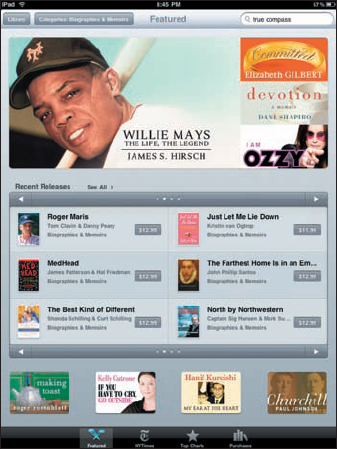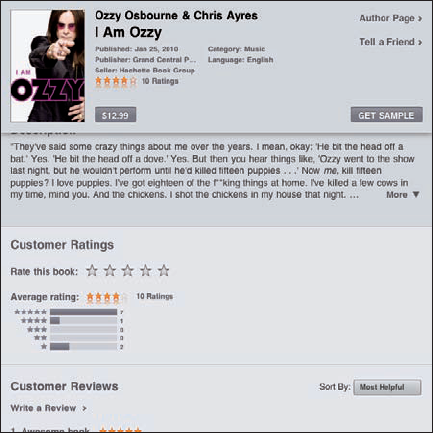In This Chapter
Opening up to iBooks
Reading books
Shopping for iBooks
Reading electronic periodicals
Don't be surprised if you have to answer this question from an inquisitive child someday: "Is it true, Grandpa, that people once read books on paper?"
That time may still be a ways off, but it somehow doesn't seem as farfetched anymore, especially now that Apple has signed on as a major proponent in the burgeoning electronic books revolution.
Don't get us wrong; we love physical books as much as anyone and are in no way urging their imminent demise. But we also recognize the real-world benefits behind Apple's digital publishing efforts, and those by companies such as Amazon.com, which manufactures what is, for now, the market-leading Kindle electronic reader. As you discover in this chapter, the Kindle plays a role on the iPad as well.

For its part, the iPad makes a terrific electronic reader, with color and dazzling special effects, including pages that turn like a real book.
We open the page on this chapter to see how to find and purchase books for your iPad, and how to read them after they land on your virtual bookshelf. But first we look at why you might want to read books and periodicals on your iPad.
We've run into plenty of skeptics who beg the question, "What's so wrong with the paper books that folks have only been reading for centuries that we now have to go digital?" The short answer is there's nothing wrong with physical books — except maybe that paper, over the long term, is fragile — and they tend to be bulky, a potential impediment for travelers.
On the other hand, when asked why he prefers paper books, Bob likes to drop one from shoulder height and ask, "Can your iPad (or Kindle) do that?"
Having said that, though, now consider the electronic advantages:
No more weighty constraints: You can cart a whole bunch of e-books around when you travel, without breaking your back. To the avid bookworm, this potentially changes the whole dynamic in the way you read. Because you can carry so many books wherever you go, you can read whatever type of book strikes your fancy at the moment, kind of like listening to a song that fits your current mood. You have no obligation to read a book from start to finish before opening a new bestseller, just because that happens to be the one book, maybe two, that you have in your bag. In other words, weighty constraints are out the window.
Feel like reading a trashy novel? Go for it. Rather immerse yourself in classic literature? Go for that. You might read a textbook, cookbook, children's book, or biography. And you can switch among them at will, before finishing any single title.
Flexible fonts and type sizes: With e-books, or what Apple prefers to call iBooks, you can change the text size and fonts on the fly, quite useful for those of you with less than 20-20 vision.
Get the meaning of a word on the spot: No more searching for a physical dictionary. You can look up an unfamiliar word on the spot.
Search: Looking to do research on a particular subject? Enter a search term to find each and every mention of the subject in the book you're reading.
Read in the dark: The iPad has a high-resolution backlit display so that you can read without a lamp nearby, which is useful in bed when your partner is trying to sleep.
Warning
Truth is, there are two sides to this backlit story. The grayscale electronic ink displays found on Amazon's Kindle and several other e-readers may be easier on the eyes and reduce fatigue, especially if you read for hours on end. And while you may indeed have to supply your own lighting source to read in low-light situations, those screens are easier to see than the iPad screen when you're out and about in bright sunshine.
To start reading electronic books on your iPad, you have to fetch the iBooks app in the App Store. (For more on the App Store, consult Chapter 7).
As you might imagine, the app is free, and it comes with access to Apple's brand new iBookstore, of which we have more to say later in this chapter. For now just know that it's an inviting place to browse and shop for books 24 hours a day. And as a bonus for walking into this virtual bookstore, you'll receive a free electronic copy of Winnie-the-Pooh.
A.A. Milne's children's classic and all the other books you end up purchasing for your iPad library turn up on the handsome wooden bookshelf, shown in Figure 11-1. The following basics help you navigate the iBooks main screen:
Change the view: If you'd prefer to view a list of your books rather than use this Bookshelf view, tap the button toward the upper-right corner of the screen (labeled in Figure 11-1). In this view, you can sort the list by title, author, or category (as shown in Figure 11-2), or you can rearrange where books appear on the bookshelf.
Rearrange books on the bookshelf: To perform this feat, tap Bookshelf from the List view and tap Edit (in the upper-right corner). Now press your finger against the icon to the right with the three horizontal lines of the book title you want to move. Drag the book up or down the list.
Remove a book from the bookshelf: In the List view, tap Edit and then tap the red circle with the white line to the left of the book title you want to remove. Then tap Delete. In the Bookshelf view, tap Edit and then tap the black circle with the white X that appears in the upper-left corner of a book cover. Then tap Delete.
Of course, here we are telling you how to get rid of a book before you've even had a chance to read it. How gauche. The next section helps you start reading.
To start reading a book, tap it — you can start with the Pooh book now. The book leaps off the shelf, and at the same time, it opens to either the beginning of the book or the place where you left off.
Even from the very title page you can appreciate the color and beauty of Apple's app, as well as the navigation tools shown in Figure 11-3.
Tip
While lounging around reading, and especially if you're lying down, we recommend that you use the screen rotation lock (shown back in Chapter 1) to stop the iPad from inadvertently rotating the display.
But you can take advantage of the iPad's VoiceOver feature to have the iPad read to you out loud. It may not be quite like having Mom or Dad read you to sleep, but it can be a potential godsend to those of you with impaired vision. For more on the VoiceOver feature, consult Chapter 13.
You've been turning pages in books your entire life, so you don't want this simple feat to become a complicated ordeal just because you're now reading electronically. Fear not, it's not. You have no buttons to press.
Instead, to turn to the next page of a book, do any of the following:
Tap or flick your finger near the right margin of the page. If you tap or flick, the page turns in a blink.
Drag your finger near the margin, and the page folds down as it turns, as if you were turning pages in a real book.
Drag down from the upper-right corner of the book, and the page curls from that spot.
Drag up from the lower-right corner, and it drags up from that spot.
Drag from the middle-right margin, and the entire page curls.
To turn to the previous page in a book, tap, flick, or drag your finger in a similar fashion, except now do so closer to the left margin. You'll witness the same cool page-turning effects.
Tip
That's what happens by default anyway. If you go into the main iPad settings and tap iBooks under Apps on the left side of the screen, you have the option to go to the next page instead of the previous page when you tap near the left margin.
Note
The iPad is smart, remembering where you left off. So if you close a book by tapping the Library button in the upper-left corner or by pressing the main Home button, you are automatically returned to this page when you reopen the book. It isn't necessary to bookmark the page (though you can, as we describe later in this chapter).
When you're reading a book, you often want to go to a specific page. Here's how:
Tap anywhere near the center of the page you're reading to summon page navigator controls, if they're not already visible.
The controls are labeled in Figure 11-3.
Drag your finger along the slider at the bottom of the screen until the chapter and page number you want appear.
Release your finger and voilà — that's where you are in the book.
Books you read on your iPad have tables of contents, just like almost any other book. Here's how you use a table of contents on your iPad:
With a book open on your iPad, tap the Table of Contents/Bookmark button near the top of the screen.
The Table of Contents screen shown in Figure 11-4 appears.
Tap the chapter, title page, or another entry to jump to that page.
Alternatively, tap the red Resume button that appears at the upper-right reaches of the screen to return to the previous location in the book.
Moving around to a particular location on the iPad is almost as simple as moving around a real book, and as we explain in the earlier section "Turning pages," Apple kindly returns you to the last page you were reading when you close a book.
Still, occasionally, you want to bookmark a specific page so that you can easily return. To insert a bookmark somewhere, do either of the following:
Press your finger and hold it down against any text on a page. A Bookmark button appears (along with Dictionary and Search buttons that we address in a moment) when you lift your finger. Tap the Bookmark button to set a bookmark. The word you bookmarked is highlighted in yellow.
You can also bookmark a paragraph or passage by tapping on text and then expanding the area of highlighted text using the selection markers that appear. As before, tap the Bookmark button to finish the job.
After you set a bookmark, here's what you can do with them:
To find the bookmark later, tap the Table of Contents/Bookmark button and then tap Bookmarks (if it's not already selected). Your bookmark is listed along with the chapter and page citations, the date you bookmarked the page, and a phrase or two of surrounding text, as the example in Figure 11-5 shows. Tap to return to that page in the book.
To remove a bookmark, touch and hold the word and tap Unbookmark. Or, from the bookmarks list, swipe your finger in either direction along a bookmark entry and tap the red Delete button that appears.
Tip
To change the highlighted color of a bookmark from yellow to green, blue, pink, or purple, touch and hold the bookmarked word and tap to the color you want to alter.
If you want to enlarge the typeface size (or make it smaller), here's how:
Tap the font button at the upper-right corner of the screen.
It's labeled in Figure 11-3.
Tap the uppercase A.
The text swells up right before your eyes so that you can pick a size you're comfortable with.
To make it smaller, tap the lowercase a instead.
If you want to change the fonts, tap the Fonts button and then tap the font style you want to switch to. Your choices are Baskerville, Cochin, Palatino, Times New Roman, and Verdana. We don't necessarily expect you to know what these look like just by the font names — fortunately you get to examine the change right before your eyes. The currently selected font style is indicated by a check mark.
If you want to find a passage in a book but just can't remember where it is, try searching for it. Here's how:
Tap the magnifying glass Search icon to enter a search phrase on the virtual keyboard that slides up from the bottom.
All the occurrences in the book turn up in a window under the Search icon.
Tap one of the items to jump to that portion of the book.
You can also search Google or the Wikipedia online encyclopedia using the buttons at the bottom of the search results. If you do so, the iBooks app closes and the Safari browser fires up Google or Wikipedia, with your search term already entered.
Bob and Ed love browsing in a physical bookstore. But the experience of browsing Apple's new iBookstore, while certainly different, is equally pleasurable. Apple makes it a cinch to search for books you want to read, and even lets you peruse a sample prior to parting with your hard-earned dollars. To enter the store, tap the Store button in the upper-left corner of your virtual bookshelf or your library List view.
A few things to keep in mind: The iBooks app and iBookstore, at least in the days before our own book was published, is only available to U.S. customers. Apple's store had some 60,000 titles at launch, including works from major publishers like Hachette, HarperCollins, Macmillan, Penguin, and Simon & Schuster, as well as several independents. Random House was the only holdout among big-name publishers at press time; we hope that's no longer the case by the time you read this, but business is business.
Many bestsellers in the joint cost $12.99, though some fetch $9.99 or less. In fact, Apple even has a $9.99-or-less section, the virtual equivalent of the bargain rack. And free selections are available. On the other hand, the late Senator Edward M. Kennedy's memoir, True Compass, commands $16.99.
You have several ways to browse for books in the iBookstore. The top half of the screen shows ever-changing ads for books that fit a chosen category, Biographies & Memoirs in the example shown in Figure 11-6. (Though he hasn't read the book yet, Ed as a kid was a huge fan of Willie Mays, a.k.a. the Say Hey Kid.) But you can also browse Recent Releases in the particular category you have in mind. The left- and right-pointing arrows indicate more recent releases to peek at. Or tap See All for many more selections.
To choose another category of books, tap the Categories button to summon the list shown in Figure 11-7; you have to scroll to see the bottom of the list.
Now look at the bottom of the screen. You see the following icons:
Featured: This is where we've been hanging out so far. Featured works are the books being promoted in the store. These may include popular titles from Oprah's Book Club or an author spotlight from the likes of Twilight writer Stephenie Meyer.
NYTimes: Short for The New York Times, of course. These books make the newspaper's famous bestsellers lists, which are divided into fiction and nonfiction works. The top ten books in each list are initially shown. To see more titles, tap Show More at the bottom of the screen. You have to scroll down to see it.
Top Charts: Here Apple is showing you the most popular books in the iBookstore. You find a list for Top Paid Books and Top Free Books. Once more, you can see more than the top ten shown in each category by tapping Show More.
Purchases: Tapping here shows you the books you've already bought. In this area, you can also check out your iTunes account information, tap a button that transports you to iTunes customer service, and redeem any iTunes gift cards or gift certificates.
In the upper-right corner of the iBookstore is a search field, similar to the Search field you see in iTunes. Using the virtual keyboard, type in an author name or title to find the book you're looking for.
Tip
If you like freebies, search for the word free in the iBookstore. You'll find dozens of (mostly classic) books that cost nothing, and you won't even have to import them. See the section "Finding free books outside iBookstore," later in this chapter, for more places to find free books.
To find out more about a book you come across in the iBookstore, you can check out the detail page and other readers' reviews or read a sample of the book. Follow these steps to navigate the detail page:
Tap its cover.
An information screen similar to the one shown for I Am Ozzy in Figure 11-8 appears. You can see when the book was published, read a description, and more.
Tap Author Page to see other books by that writer.
If you tap Tell a Friend, the iPad fires up your e-mail app, with the subject line filled in with "Check out I Am Ozzy" in the case of this example.
A picture of the book cover, its release date and rating, and a View Item link are embedded in the body of the message.
Check out customer reviews and ratings. Flick or drag to scroll down the overlay and see all the reviews.
Throw in your own two cents if you've already read it by tapping Write a Review.
Of course the best thing you can do to determine whether a book is worth buying is to read a sample. Tap Get Sample, and the book cover almost immediately lands on your bookshelf. You can read it like any book, up until that juncture in the book where your free sample ends. Apple has placed a Buy button inside the pages of the book to make it easy to purchase it if you're hooked. The word Sample also appears on the cover, to remind you that this book isn't quite yours — yet.
Assuming that the book exceeds your lofty standards and you are ready to purchase it, here's how to do so:
Tap the price shown in the gray button on the book's information page.
Upon doing so, the dollar amount disappears and the button becomes green and carries a Buy Book label. If you tap a free book instead, the button is labeled Get Book.
Tap the Buy Book/Get Book button.
Enter your iTunes password to proceed with the transaction.
The book appears on your bookshelf in an instant, ready for you to tap it and start reading.
Tip
If you buy another book within 15 minutes of your initial purchase, you won't be prompted for your iTunes password again.
The business world is full of examples where one company competes with another on some level only to work with it as a partner on another. When the iPad first burst onto the scene in early April 2010, pundits immediately compared it to Amazon's Kindle, the market-leading electronic reader. Sure the iPad had the larger screen and color, but Kindle had a few bragging points too, including longer battery life (up to about two weeks versus about 10 hours for the iPad), a lighter weight, and a larger selection of books in its online bookstore.
But Amazon has long said it wants Kindle books to be available for all sorts of electronic platforms, and the iPad, like the iPhone and iPod touch before it, is no exception. So we recommend taking a look at the free Kindle app for the iPad, especially if you've already purchased a number of books in Amazon's Kindle Store and want access to that wider selection of titles.
Meanwhile, we haven't tried them all, and we know it's hard enough competing against Apple (or Amazon). But we'd be selling our readers short if we didn't at least mention that you can find several other e-book-type apps for the iPad in the App Store. As this book goes to press, you can have a look at the following apps, just to name a few:
Cloud Readers from Satoshi Nakajima (free)
eBooks by Kobo HD from Indigo Books and Music (free)
ReadDemon PDF Reader from DeadNick ($4.99)
Stanza from Lexcycle (free)
See Chapter 7 for details about finding and downloading apps.
Tip
Apple supports a technical standard called ePub, the underlying technology behind thousands of free public-domain books. You can import these to the iPad without shopping in the iBookstore. Such titles must be DRM-free, which means they are free of digital rights restrictions.
To import ePub titles, you have to download them to your PC or Mac (assuming that they're not already there) and then sync them to the iPad through iTunes.
You can find ePub titles at numerous cyberspace destinations, among them
Feedbooks (
www.feedbooks.com)Google Books (
http://books.google.com)Project Gutenberg (
www.gutenberg.us)Smashwords (
www.smashwords.com)
Those of us in the newspaper business know that it has been tough sledding in recent years. The Internet, as it has in so many areas, has proved to be a disruptive force in media.
It remains to be seen what role Apple generally, and the iPad specifically, will play in the future of electronic periodicals or in helping to turn around sagging media enterprises. It's also uncertain which pricing models will make the most sense from a business perspective.
What we can tell you is that reading newspapers and magazines on the iPad is not like reading newspapers and magazines in any other electronic form. The experience is really slick, but only you can decide whether it's worth paying the tab (in the cases where you do have to pay).
Fine publishing apps worth checking out include USA TODAY, where Ed works, The Wall Street Journal, Time Magazine, The New York Times, Reuters News Pro, BBC News, and Popular Science.
We also highly recommend fetching the free Zinio Magazine Newsstand & Reader app. It's a terrific way to read magazines like Rolling Stone, The Economist, Macworld, PC Magazine, Car & Driver, National Geographic, Spin, Business Week, U.S. News & World Report, and many more. You can buy single issues of a magazine or subscribe, and sample and share some articles without a subscription.
You have to pay handsomely or subscribe to some of these newspapers and magazines, which you find not in the iBookstore but in the regular App Store, which we cover in Chapter 7.
Let us pause a moment here in the middle of the book to thank you again for reading our book because as this chapter points out, you have a lot of rich reading to do on your iPad.


